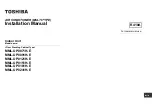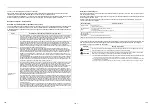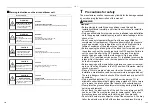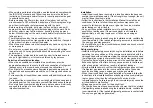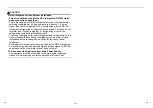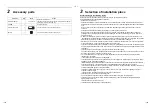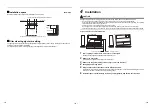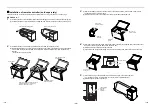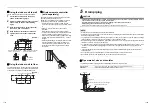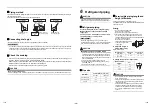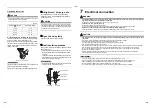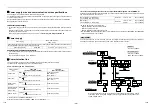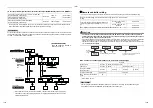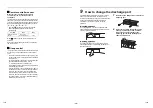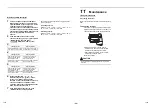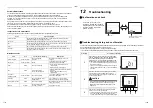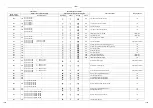
– 11 –
Fixing the indoor unit to wall
Fix the indoor unit to the wall as described below.
1
Fix four M8 anchor bolts to the wall, as
shown in the following figure.
2
Attach the bolts preciously to the upper two
anchor bolts, as shown in the following
figure.
3
Open the knockout hole at rear side of the
indoor unit, with a screwdriver.
4
Hang the indoor unit to the anchor bolts.
5
Tighten the nuts to the two lower anchor
bolts.
(Unit: mm)
Fixing the indoor unit to floor
To fix the indoor unit to the floor, pass two anchor bolts
attached on the floor through a hole of the bottom plate
of the indoor unit. Tighten and fix it with the nuts.
(Unit: mm)
Wireless remote controller
(sold separately)
The signal receiving unit of indoor unit can receive a
signal by distance within approx. 7 m.
Based upon it, determine a place where the remote
controller is operated and the installation place.
• Operate the remote controller, confirm that the
indoor unit receives a signal surely, and then install
it.
• Keep 1 m or more from the devices such as
television.
(Disturbance of image or noise may generate.)
• To prevent a malfunction and reception failure of the
remote controller, select a place where it is not
influenced by a fluorescent light, equipment emitting
infrared rays (Electronic whiteboard etc.), or direct
sunlight.
• Switching the setting (A-B selection) of the wireless
remote controllers and the signal receiving unit
enables two indoor units installed in a room to be
respectively operated using two wireless remote
controllers.
700
125
215
133
440
57
520
Mount the upper two nuts as
shown in the figure below.
Tighten the lower two nuts after
the unit has been mounted.
1 to 2
15 MAX
Screwdriver
Knockout hole
150
400
275
Rear
Anchor bolts (two at left and right)
Front
7 m
or
les
s
5
Drain piping
CAUTION
CAUTION
•
Following the Installation Manual, perform the drain piping work so that water is properly drained. Apply a
heat insulation so as not to cause a dew condensation.
Inappropriate piping work may result in water leakage in the room and wet furniture.
•
After opening the knockout hole, deburr the edge.
Burrs adhered to opening of the knockout hole may causes an injury by touching it.
NOTE
• Provide the indoor drain piping with proper heat insulation.
• Provide the area where the pipe connects to the indoor unit with proper heat insulation. Improper heat insulation
will cause condensation to form.
• The drain pipe must be sloping downward (at an angle of 1/100 or more), and do not run the pipe up and down
(arched shape) or allow it to form traps. Doing so may cause abnormal sounds.
• Restrict the length of the traversing drain pipe to 20 meters or less. For a long pipe, provide support brackets at
intervals of 1.5 to 2 meters to prevent flapping.
• For collective piping, the pipes must be equivalent to VP30 and sloping downward at an angle of 1/100 or more.
• If clearance occurs between piping/wiring and drain hose in opening the knockout hole, apply putty to the
clearance.
• If the pipe passes through a fire retarding division, apply incombustible material (putty) to the clearance at
penetration part.
• Do not provide any air vents. Otherwise, the drain water will spout, causing water to leak.
• Do not allow any force to be applied to the connection area with the drain pipe.
Pipe material, size and insulator
The following materials for piping work and insulating process are procured locally.
Pipe material
Hard vinyl chloride pipe, pipe elbow (Nominal outer diameter Dia.20 mm)
Insulator
Foamed polyethylene foam, thickness: 10mm or more
Drain pan
Drain hose
Use adhesive for hard polyvinyl chloride pipe
Hard polyvinyl chloride pipe
Elbow
Insulation
21-EN
22-EN
Summary of Contents for MML-UP0071H-E
Page 30: ...EB99841101 ...

